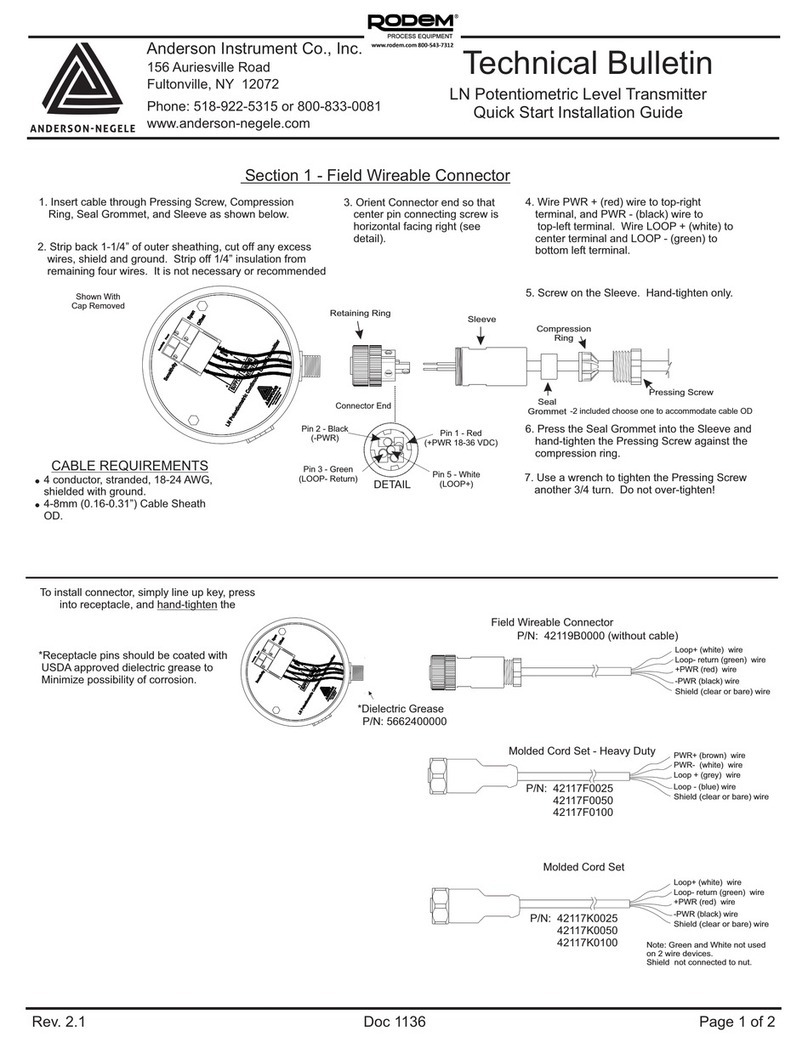
PAGE 3
Section 1 General
1.1 INTRODUCTION1.1 INTRODUCTION
1.1 INTRODUCTION1.1 INTRODUCTION
1.1 INTRODUCTION
The Anderson “LD/LA” standard and pharmaceutical series level transmitters are unique
devices designed for level control applications where pressure based technology provides
the best overall solution, but where bottom access for the sensor is not available or prefer-
able. These sensors are designed to be mounted on the top of the vessel with the extension
tube positioning the sensing diaphragm near the bottom of the tank. Common applications
include rotary filler bowls, surge tanks and small processing storage vessels where bottom
access is impractical. With no moving parts, no air required, and wide compensated
temperature range the LD/LA provides accuracy and repeatability in applications where
other sensing technologies have been proven unreliable.
1.2 SPECIFICATIONS1.2 SPECIFICATIONS
1.2 SPECIFICATIONS1.2 SPECIFICATIONS
1.2 SPECIFICATIONS
Performance
Upper Range Limit (URL) 72" water column (w.c.)
Minimum Span: 30" w.c.
Over-Range Capacity: 2.5 times the URL (180" w.c.)
Accuracy: ± 0.75% of URL (± 0.5" w.c.)
Repeatability: within ±0.3% of URL (± 0.2" w.c.)
Stability: Within published specification for one
(1) year minimum
Compensated Temp. Range: 30°F to 220°F (-1°C to 104°C)
(process)
Compensated Temp. Range: 30°F to 120°F (-1°C to 49°C)
(ambient)
Effect of Process/Ambient
Temperature Change: ± 0.40% of URL per 10°F
Humidity: 0-100% RH, Condensing
Response Time: 526 mSec
Power Signal
Output: 4-20mA dc
Loop Power required: 12-40 Vdc
Effect of Voltage Change: ± 0.05% of URL per 30 volts
Load Impedance: 1550 Ohms at 40 VDC
Cable Recommended: 18-24 AWG, .169" to .209" diameter,
stranded, 2 conductor with ground,
shielded and PVC coated for use with
seal-tight wire grommet
Materials/Construction
Housing /Wiring Head: 304 stainless steel
Wetted Parts: 316L stainless steel
Surface Finish (LD): Ra=25 microinches or better (wettedparts)
Surface Finish (LA - Pharm.) Ra=15 microinches or better (wetted parts)
Housing Rating: NEMA 4X, IP-65
Agency Approvals
Electronic "Noise" Designed to meet IEC 801-2, -3 and -4,
Immunity: Level 3, CE Compliant
Sanitary Standards: Complies with all applicable provisions
of 3-A Sanitary Standards (74-00).
Hazardous Locations: For LA only: UL, Intrinsically safe for use in CLass 1, Div. 1 Groups A-D.
Warranty: All units are covered by a two (2) year warranty against defects in material
and workmanship when installed and maintained according to the instruction
manual provided.





























